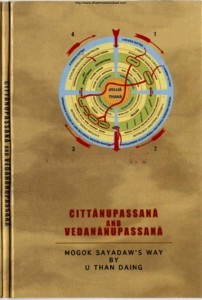
Cittanupassana and Vedananupassana with the subtitle Mogok Sayadaw‘s Way is a compilation of detailed instructions on the two meditation forms Meditation of Feeling (Vedanannupassana) and Meditation on Mind “Cittanupassana” as taught by Mogok Sayadaw.
Than Daing places the practices in the larger system of Burmese Buddhist meditation, he explains he diferent stages and uses several pages on illustration that will be helpful to the devoted student. Download the free ebook here:
 Cittanupassana And Vedananupassana
Cittanupassana And Vedananupassana
About Cittanupassana And Vedananupassana
“Cittanupassana” and “Vedananupassana” are two distinct meditation forms rooted in Buddhist practices, each focusing on specific aspects of the practitioner’s mental and experiential states. These meditation techniques are part of the broader framework of mindfulness (sati) and insight (vipassana) meditation, integral to the Buddhist path towards enlightenment.
Cittanupassana – mindfulness of the mind
“Cittanupassana” translates to “mindfulness of the mind” or “contemplation of the mind.” This meditation practice involves observing and understanding the nature of the mind itself—the thoughts, emotions, and mental processes that arise. Practitioners engage in a deep and non-judgmental observation of the mind’s contents, allowing thoughts and emotions to arise and pass without attachment or aversion.
Through cittanupassana, practitioners cultivate awareness of the ever-changing nature of their mental states. They learn to identify patterns of thought, emotions, and mental habits, gaining insight into the impermanent, impersonal, and ultimately unsatisfactory nature of these mental phenomena. This practice helps individuals develop a sense of detachment from the mind’s fluctuations, leading to greater mental clarity, equanimity, and a deeper understanding of the nature of consciousness.
Vedananupassana – mindfulness of feelings
“Vedananupassana” translates to “mindfulness of feelings” or “contemplation of sensations.” This meditation form focuses on the experiential aspect of feelings or sensations—both physical and mental—that arise in response to various stimuli. Feelings are categorized into three main types: pleasant, unpleasant, and neutral.
During vedananupassana, practitioners attentively observe these feelings as they arise and subside without clinging to them or seeking to avoid them. By developing mindfulness of feelings, individuals gain insight into the nature of craving and aversion that often accompany these sensations. This practice helps practitioners recognize the impermanent and unsatisfactory nature of feelings, leading to a reduced reactivity to them and a deeper understanding of the causes of suffering.
Both cittanupassana and vedananupassana are integral components of mindfulness and insight meditation, supporting the overall goal of liberating oneself from the cycle of suffering (dukkha) as outlined in Buddhist teachings. Through consistent practice of these meditation forms, practitioners develop a clearer understanding of the impermanent, interconnected, and selfless nature of all phenomena, which ultimately contributes to the attainment of wisdom, liberation, and the realization of enlightenment.


Don’t click on the line
PDF downloadCittanupassana And Vedananupassana
Click on its cover page of the e-book and it will start downloading.
Dear brothers. I could not download the book Cittanupassana and Vedananupassana. I would like to receive your help in order to receive it or download it. Thank you!